17
Catalog
I Difference Between Solid Capacitors and Liquid Capacitors | |
II Types and Features of Solid Capacitors | 2.1 High stability |
2.2 Long Service Life | |
2.3 Low ESR and High-rated Ripple Current. | |
III Types of Capacitors | 3.1 Inorganic dielectric capacitors |
3.2 Organic dielectric capacitors | |
3.3 Electrolytic capacitors | |
IV Advantages and Disadvantages of Solid Capacitors | 4.1 Advantages |
4.2 Disadvantages | |
I Introduction
Solid capacitors are called: solid aluminum electrolytic capacitors. The biggest difference between it and ordinary capacitors (also called liquid aluminum electrolytic capacitors) is that different dielectric materials are used. The liquid aluminum capacitor dielectric material is electrolyte, and the solid capacitor dielectric material is conductive polymer material.
In view of the problems of liquid electrolytic capacitors, solid aluminum electrolytic capacitors have emerged. Since the 1990s, aluminum electrolytic capacitors have adopted a solid conductive polymer material instead of an electrolyte as a cathode, and have achieved innovative development. The conductivity of conductive polymer materials is usually 2 to 3 orders of magnitude higher than that of electrolytes. Aluminum electrolytic capacitors can greatly reduce ESR and improve temperature and frequency characteristics. And because of the good process ability of polymer materials, it is easy to encapsulate. The earth has promoted the development of the chipping of aluminum electrolytic capacitors.
II Types and Features of Solid Capacitors
There are two main types of commercially available solid aluminum electrolytic capacitors: organic semiconductive aluminum electrolytic capacitors (OS-CON) and polymer conductor aluminum electrolytic capacitors (PC-CON). The structure of the organic semiconductor aluminum electrolytic capacitor is similar to that of the liquid aluminum electrolytic capacitor, and the vertical insert package is often used. The difference is that the cathode material of the solid aluminum polymer electrolytic capacitor replaces the electrolyte with a solid organic semiconductor extract, which effectively solves the problems of evaporation, leakage, and flammability of the electrolyte while improving various electrical properties. Solid aluminum polymer chip capacitors are a unique structure that combines the characteristics of aluminum electrolytic capacitors and tantalum capacitors.
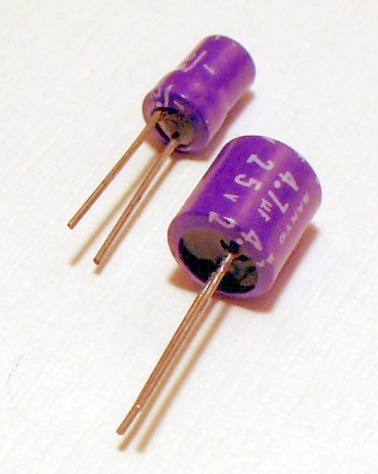
SANYO OS-CON
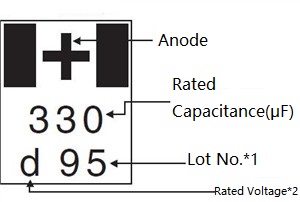
Appearance of PC-CON
Like liquid aluminum electrolytic capacitors, solid aluminum polymers are mostly in the form of patches. A high conductivity polymer electrode film is deposited on alumina as the cathode, and carbon and silver are the cathode extraction electrodes, which is similar to the solid tantalum electrolytic capacitor structure.
2.1 High Stability
solid aluminum electrolytic capacitors can work stably in high temperature environment. Solid aluminum electrolytic capacitors can directly improve the performance of the motherboard. At the same time, it is suitable for power supply filtering due to its stable impedance over a wide temperature range. It can effectively provide a stable and abundant power supply, which is especially important in overclocking. Solid capacitors still work well in high temperature environments, maintaining a variety of electrical performance. Its capacitance does not vary by more than 15% over the full temperature range, significantly better than liquid electrolytic capacitors. At the same time, the capacitance of the solid electrolytic capacitor is basically independent of its working voltage, thus ensuring its stable operation in a voltage fluctuation environment.
2.2 Long Service Life
solid aluminum electrolytic capacitors have an extremely long service life (more than 50 years of service life). Compared with liquid aluminum electrolytic capacitors, it can be counted as "long life". It will not be broken down, and there is no need to worry about the electrolyte electrolyte drying and leakage affecting the stability of the motherboard. Due to the lack of liquid electrolyte problems, solid aluminum electrolytic capacitors make the motherboard more stable and reliable. Solid electrolytes do not evaporate and even burn like liquid electrolytes in high heat environments. Even if the temperature of the capacitor exceeds its tolerance, the solid electrolyte is only melted, which does not cause the capacitor metal casing to burst and is therefore safe. The working temperature directly affects the life of the electrolytic capacitor, and the solid electrolytic capacitor and the liquid electrolytic capacitor have a relatively long life under different temperature environments.
2.3 Low ESR and High-rated Ripple Current
ESR (Equivalent Series Resistance) refers to the series equivalent resistance, which is a very important indicator of capacitance. The lower the ESR, the faster the capacitor charge and discharge. This performance directly affects the decoupling performance of the microprocessor power supply circuit. The advantages of the low ESR characteristics of the solid electrolytic capacitor in the high frequency circuit are more obvious. It can be said that the low ESR characteristic at high frequencies is a watershed between the performance difference between solid electrolytic capacitors and liquid capacitors. Solid aluminum electrolytic capacitors have very low ESR and very low energy dissipation. The extremely low ESR characteristics of solid capacitors under high temperature, high frequency and high power operating conditions can fully absorb the high amplitude voltage generated between the power lines in the circuit to prevent its interference with the system. At present, the CPU power consumption is very large, the main frequency has far exceeded 1GHz, and the peak current of the CPU reaches 80A or more, and the output filter capacitor is close to the working critical point. On the other hand, the CPU uses a variety of operating modes, most of which are in the conversion process of the operating mode. When the CPU is switched from a low-power state to a full-load state, the large amount of energy required for the instantaneous (usually less than 5 milliseconds) switching of the CPU comes from the capacitance in the CPU power supply circuit. At this time, the high-speed charge and discharge characteristics of the solid capacitor can be instantaneous. Output high peak current to ensure sufficient power supply and ensure stable CPU operation.
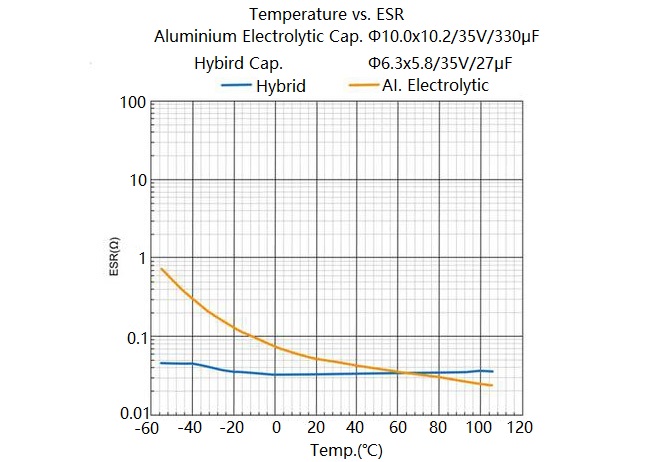
III Types of Capacitors
The type of capacitor must first be classified according to the type of medium. According to the medium, it can be divided into three categories: inorganic dielectric capacitors, organic dielectric capacitors and electrolytic capacitors.
3.1 Inorganic Dielectric Capacitors
It includes familiar ceramic capacitors and mica capacitors, we often see ceramic capacitors on the CPU. Ceramic capacitors have a good overall performance and can be applied to GHz-class UHF devices such as CPU/GPU. Of course, its price is also very expensive.
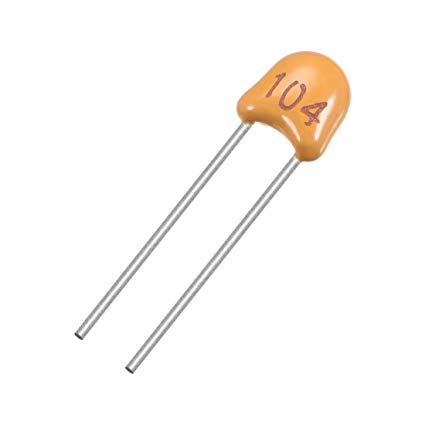
A Ceramic Capacitor
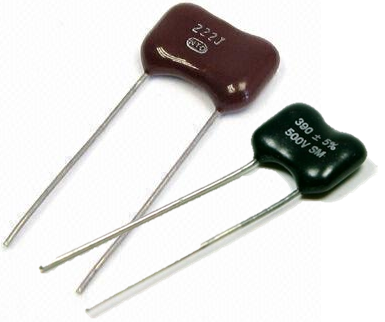
Mica Capacitors
3.2 Organic Dielectric Capacitors
Such as film capacitors. Such capacitors are often used in speakers, its characteristics are more sophisticated, high temperature and high pressure.
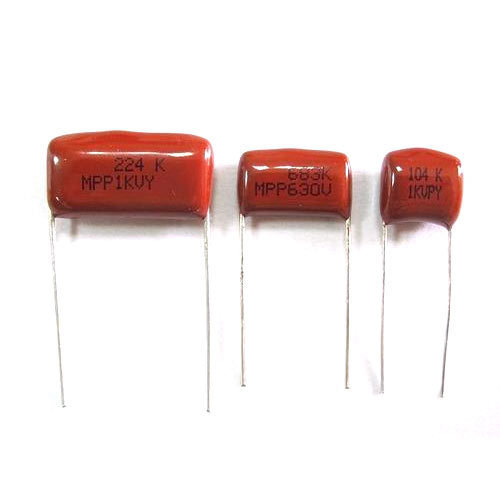
Film Capacitors
3.3 Electrolytic Capacitors
Aluminium capacitors, which are well known, are actually electrolytic capacitors. If the capacitor is the most important and irreplaceable component in electronic components, then electrolytic capacitors occupy half of the entire capacitor industry. The annual output of electrolytic capacitors in China is 30 billion, and the annual average growth rate is as high as 30%, accounting for more than 1/3 of the global electrolytic capacitor production. The classification of electrolytic capacitors, the traditional method is based on the anode material, such as aluminum, tantalum or niobium. However, this method of judging the performance of the capacitor by the anode is outdated. The key to determining the performance of the electrolytic capacitor is not the anode but the electrolyte, that is, the cathode.
According to the classification of cathode materials, electrolytic capacitors can be classified into electrolytes, manganese dioxide, TCNQ organic semiconductors, solid polymer conductors, and the like. On the right is a simple, incomplete capacitance classification table that lists some of the most common types of capacitors on board devices. This intuitive tree table provides an intuitive understanding of the classification and naming of capacitors. . Commonly used capacitors are electrolyte capacitors, solid capacitors, and tantalum capacitors. In the eyes of many users, whether motherboards, graphics cards, industrial control boards and other products use solid capacitors determines whether the board is in a higher grade. In the past two years, solid-state capacitors have developed rapidly in domestic technology, and the original SANYO has become a unique show. Nowadays, many domestic and foreign brands are vying for the world. Solid-state capacitors have already gone down the altar. Many common electronic and digital products use these products in large quantities. The solid-state capacitors are similar to the common aluminum electrolytic capacitors, some are replaceable, and there is a solid capacitor, sheet, for Replace the common tantalum capacitor.
![]()
Solid Polymer Electrolytic Capacitors
IV Advantages and Disadvantages of Solid Capacitors
4.1 Advantages
The dielectric of liquid electrolytic capacitors is a liquid electrolyte. The liquid particles are very active at high temperatures and generate pressure on the inside of the capacitor. Its boiling point is not very high, so there may be a situation of flashing. When the solid particles are at a high temperature, whether the particles are soaring or active, they are lower than the liquid electrolyte, and its boiling point is as high as 350 degrees Celsius, so it is almost impossible to explode. In theory, solid capacitors are almost impossible to burst. The solid capacitor has better performance than the traditional electrolytic capacitor in the equivalent series impedance performance. According to tests, the solid capacitor has a very small equivalent series resistance at high frequency operation, and the conductivity frequency is excellent, and the electrical impedance is reduced. The lower heat output features the most obvious performance between 100KHz and 10MHz.
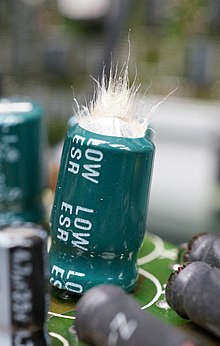
A Exploded Capacitor
Conventional electrolytic capacitors are more susceptible to the temperature and humidity of the environment in use, and are slightly less stable in terms of high and low temperature stability. Even at sub-55 degrees Celsius to 105 degrees Celsius, the ESR (Equivalent Series Resistance) impedance of a solid capacitor can be as low as 0.004 to 0.005 ohms. In terms of capacitance value, the liquid capacitance is below 20 degrees Celsius, which will be lower than the capacitance value indicated. The lower the temperature, the lower the capacitance value will be. The capacitance will drop by about 13% at minus 20 degrees Celsius. At minus 55 degrees, the capacity is reduced to 37%. Of course, this has no effect on the average user, but for players who use liquid nitrogen as the ultimate overclocking, the solid capacitors can guarantee that the capacitance will not be affected by the temperature drop, resulting in a great compromise in overclocking stability. Because the solid capacitors have a capacitance value of less than 5% at minus 55 degrees, they do have many advantages, but they don't apply at all times. The low-frequency response of solid-state capacitors is not as good as that of electrolytic capacitors. If they're used for parts involving sound effects, the best sound quality will not be obtained.
4.2 Disadvantages
Whether it is a solid capacitor or an electrolytic capacitor, their main function is to filter out clutter, so as long as the capacity reaches a certain value, as long as the capacitor The quality of its components can also ensure the stable operation of the motherboard. At this point, the electrolytic capacitor can also do this. When the solid capacitor is at 105 degrees Celsius, it has the same life as the electrolytic capacitor for 2000 hours. After the temperature is lowered, their life will increase, but the life of the solid capacitor increases more. Under normal circumstances, the operating temperature of the capacitor is 70 degrees or lower. At this time, the life of the solid capacitor may reach 23 years, almost 6 times that of the electrolytic capacitor. But is your motherboard still be used after 23 years. And even if the capacitor has such a long life, other components may not be lasted for 23 years! Compared with electrolytic capacitors, the capacity of electrolytic capacitors under the same volume and voltage is much larger than the solid capacitor. At present, most of the CPU power supply of the computer motherboard uses solid capacitors. Although the problem of explosion is avoided, the capacity redundancy is very small due to the volume limitation. Moreover, due to the capacity problem, the frequency of the CPU power supply switch has to be increased. Solid capacitors and electrolytic capacitors have capacity degradation problems during use. Circuit boards with solid capacitors have a slight fluctuation in capacity, which causes ripples in the power supply, causing the CPU to malfunction.
Therefore, in theory, the life of a solid capacitor is very high, but the life of a board using a solid capacitor is not necessarily high. Maintenance of solid-state capacitor computer board: Since the CPU power supply is often connected in parallel with multiple capacitors, there is no deformation, explosion, or liquid leakage in the solid capacitor. There is basically no way to judge which one is faulty. Therefore, in the maintenance, often take one of them (good or bad), change a large capacity capacitor (many times you can use electrolytic capacitors), this method can generally solve the problem quickly. In theory, the life of solid capacitors is very high, but there are still many faults in the actual use process. I have encountered capacitor failure problems many times during the maintenance process. At present, many manufacturers have introduced motherboards with overclocking as a selling point. Metropolis uses solid-state capacitors. The term "solid-state capacitors are more powerful" can only be said to be barely correct. It is not capacitors that determine the overclocking. The design of the line, the development of the BIOS, the quality of the CPU and the heat dissipation measures may determine the success or failure of overclocking.
What is the BIOS and What Does it Do?
So there is no saying that "replace the ordinary electrolytic capacitor on the motherboard with an all-solid capacitor to improve the overclocking performance of the motherboard." This statement is completely wrong! If you really want to say the effect of solid capacitors on overclocking, it is because it has higher pressure and temperature resistance, thus providing a certain guarantee for system stability after overclocking.
You May Also Like:
Ten Principles of DC/DC Conversion Circuit Design
What Are the Essential Differences Between PLC and Microcontrollers?
Selection of Residual Current Protector in Charging Pile
PCB Layout Tips and Tricks: The Components and Wires
Ordering & Quality
| Photo | Mfr. Part # | Company | Description | Package | Qty |
|
MC56F8245VLD | Company:NXP / Freescale | Remark:IC MCU 16BIT 48KB FLASH 44LQFP | Package:44-LQFP |
MC56F8245VLD Datasheet |
In Stock:765 Inquiry |
Inquiry |
|
P87C554SBAA,512 | Company:NXP | Remark:IC MCU 8BIT 16KB OTP 68PLCC | Package:68-LCC (J-Lead) |
P87C554SBAA,512 Datasheet |
In Stock:510 Inquiry |
Inquiry |
|
MR055C223JAA | Company:AVX Corporation | Remark:CAP CER 0.022UF 50V X7R RADIAL | Package:Radial |
MR055C223JAA Datasheet |
In Stock:167 Inquiry |
Inquiry |
|
MCF52256AG80 | Company:NXP / Freescale | Remark:IC MCU 32BIT 256KB FLASH 144LQFP | Package:144-LQFP |
MCF52256AG80 Datasheet |
In Stock:2345 Inquiry |
Inquiry |
|
STTH12R06G-TR | Company:STMicroelectronics | Remark:DIODE GEN PURP 600V 12A D2PAK | Package:263AB |
STTH12R06G-TR Datasheet |
In Stock:11035 Inquiry |
Inquiry |
|
MC9RS08KB2CSC | Company:NXP | Remark:IC MCU 8BIT 2KB FLASH 8SOIC | Package:8-SOIC (0.154", 3.90mm Width) |
MC9RS08KB2CSC Datasheet |
In Stock:10913 Inquiry |
Inquiry |
|
XC7A200T-2FBG484I | Company:Xilinx | Remark:IC FPGA ARTIX7 285 I/O 484FCBGA | Package:BGA |
XC7A200T-2FBG484I Datasheet |
In Stock:118 Inquiry |
Inquiry |
|
RC0603FR-071KL | Company:Yageo | Remark:RES SMD 1K OHM 1% 1/10W 0603 | Package:SMD |
RC0603FR-071KL Datasheet |
In Stock:39061200 Inquiry |
Inquiry |
|
MAX14515EWA+T | Company:Maxim Integrated | Remark:IC LENS DVR SMALL LIQUID 8-WLP | Package:8-WFBGA, WLCSP |
MAX14515EWA+T Datasheet |
In Stock:9184 Inquiry |
Inquiry |
|
MPC5123YVY400B | Company:NXP | Remark:IC MCU 32BIT 516FPBGA | Package:516-BBGA |
MPC5123YVY400B Datasheet |
In Stock:104 Inquiry |
Inquiry |